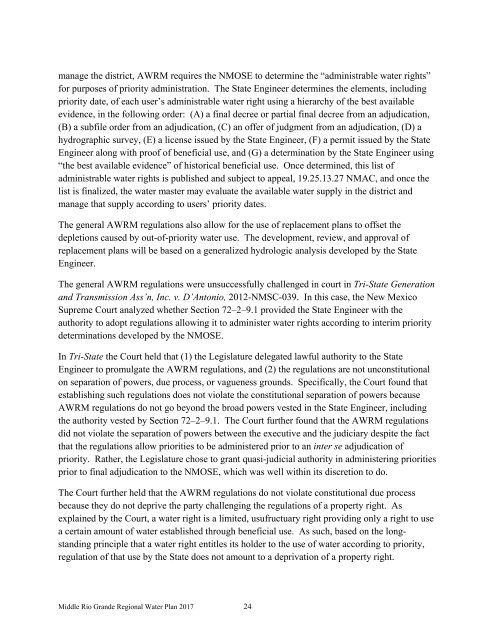Middle Rio Grande Regional Water Plan
2iUWd5b
2iUWd5b
You also want an ePaper? Increase the reach of your titles
YUMPU automatically turns print PDFs into web optimized ePapers that Google loves.
manage the district, AWRM requires the NMOSE to determine the “administrable water rights”<br />
for purposes of priority administration. The State Engineer determines the elements, including<br />
priority date, of each user’s administrable water right using a hierarchy of the best available<br />
evidence, in the following order: (A) a final decree or partial final decree from an adjudication,<br />
(B) a subfile order from an adjudication, (C) an offer of judgment from an adjudication, (D) a<br />
hydrographic survey, (E) a license issued by the State Engineer, (F) a permit issued by the State<br />
Engineer along with proof of beneficial use, and (G) a determination by the State Engineer using<br />
“the best available evidence” of historical beneficial use. Once determined, this list of<br />
administrable water rights is published and subject to appeal, 19.25.13.27 NMAC, and once the<br />
list is finalized, the water master may evaluate the available water supply in the district and<br />
manage that supply according to users’ priority dates.<br />
The general AWRM regulations also allow for the use of replacement plans to offset the<br />
depletions caused by out-of-priority water use. The development, review, and approval of<br />
replacement plans will be based on a generalized hydrologic analysis developed by the State<br />
Engineer.<br />
The general AWRM regulations were unsuccessfully challenged in court in Tri-State Generation<br />
and Transmission Ass’n, Inc. v. D’Antonio, 2012-NMSC-039. In this case, the New Mexico<br />
Supreme Court analyzed whether Section 72–2–9.1 provided the State Engineer with the<br />
authority to adopt regulations allowing it to administer water rights according to interim priority<br />
determinations developed by the NMOSE.<br />
In Tri-State the Court held that (1) the Legislature delegated lawful authority to the State<br />
Engineer to promulgate the AWRM regulations, and (2) the regulations are not unconstitutional<br />
on separation of powers, due process, or vagueness grounds. Specifically, the Court found that<br />
establishing such regulations does not violate the constitutional separation of powers because<br />
AWRM regulations do not go beyond the broad powers vested in the State Engineer, including<br />
the authority vested by Section 72–2–9.1. The Court further found that the AWRM regulations<br />
did not violate the separation of powers between the executive and the judiciary despite the fact<br />
that the regulations allow priorities to be administered prior to an inter se adjudication of<br />
priority. Rather, the Legislature chose to grant quasi-judicial authority in administering priorities<br />
prior to final adjudication to the NMOSE, which was well within its discretion to do.<br />
The Court further held that the AWRM regulations do not violate constitutional due process<br />
because they do not deprive the party challenging the regulations of a property right. As<br />
explained by the Court, a water right is a limited, usufructuary right providing only a right to use<br />
a certain amount of water established through beneficial use. As such, based on the longstanding<br />
principle that a water right entitles its holder to the use of water according to priority,<br />
regulation of that use by the State does not amount to a deprivation of a property right.<br />
<strong>Middle</strong> <strong>Rio</strong> <strong>Grande</strong> <strong>Regional</strong> <strong>Water</strong> <strong>Plan</strong> 2017 24


